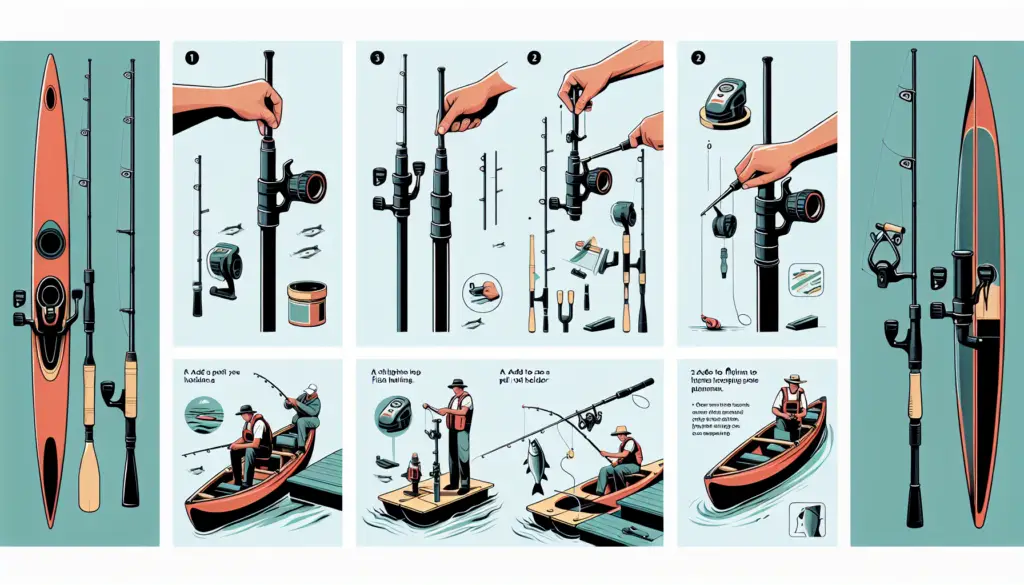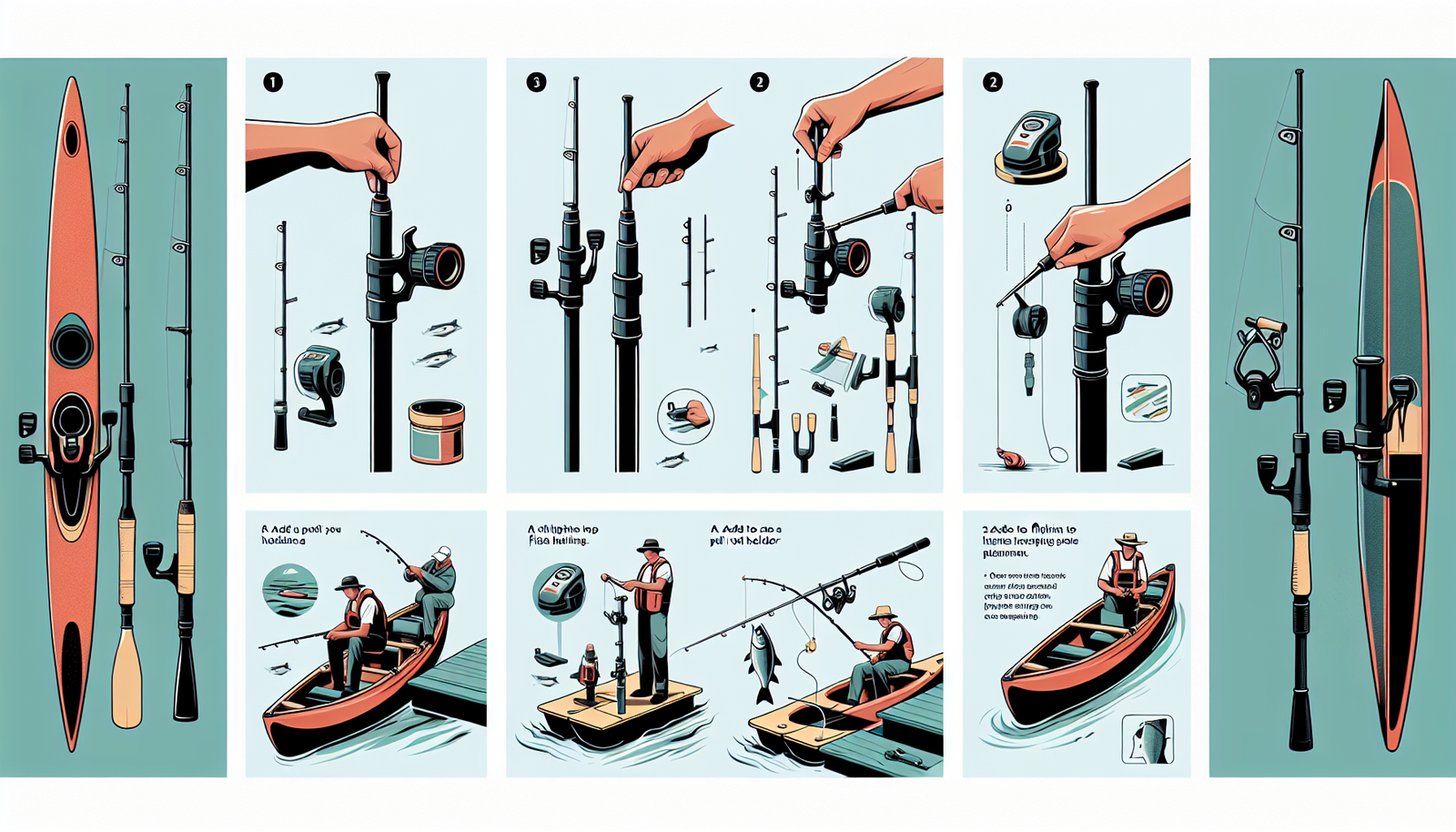So you’ve recently purchased a boat and you’re excited to take it out on the open water for a day of fishing. However, you quickly realize that you don’t have anywhere convenient to store your fishing rods while you’re on the move. Don’t worry, adding a fishing rod holder to your boat is easier than you might think. In this article, we’ll guide you through the simple steps to help you install a fishing rod holder and ensure that your fishing adventures are comfortable and organized. With a bit of DIY enthusiasm, you’ll be ready to hit the water with your favorite fishing gear in no time.

Choosing the Right Fishing Rod Holder
When it comes to fishing, having the right equipment is essential. One important piece of equipment that every angler needs is a fishing rod holder. A fishing rod holder allows you to secure your rod in place, leaving your hands free to handle other tasks such as baiting the hook, reeling in your catch, or simply enjoying the beautiful scenery around you. However, with so many options available, choosing the right fishing rod holder for your boat can be overwhelming. To make the decision easier, there are several factors you should consider.
Consider the Type of Boat
The first thing you should consider when choosing a fishing rod holder is the type of boat you have. Different types of boats require different types of rod holders. For example, if you have a small fishing kayak, you may need a rod holder that can be attached to the deck or the side of the boat. On the other hand, if you have a larger fishing boat, you may have the option to choose between several types of rod holders, such as flush mount rod holders or rail mount rod holders.
Determine the Number of Rod Holders Needed
Another factor to consider is how many rod holders you will need. This will depend on the number of fishing rods you typically use when you go fishing. If you usually fish with multiple rods, you may want to consider getting a rod holder that can accommodate two or more rods. However, if you usually fish with just one rod, a single rod holder should suffice. Additionally, you may want to consider future growth. If you anticipate adding more fishing rods to your collection, it may be wise to choose a rod holder that can easily accommodate additional rods.
Select the Material
Fishing rod holders come in a variety of materials, each with its own advantages and disadvantages. The most common materials used for rod holders are plastic, stainless steel, and aluminum. Plastic rod holders are lightweight and affordable, but they may not be as durable as metal rod holders. Stainless steel rod holders are known for their strength and corrosion resistance, making them a popular choice for saltwater anglers. Aluminum rod holders are lightweight and resistant to rust, making them a good choice for both freshwater and saltwater fishing. Consider the environment in which you will be fishing and choose a material that will best suit your needs.
Choose a Mounting Option
Once you have determined the type of rod holder, the number of rod holders needed, and the material, the final step is to choose a mounting option. There are several mounting options available, each with its own benefits. Some common mounting options include deck mounts, rail mounts, and clamp-on mounts. Deck mounts are typically secured to the boat’s deck and provide a stable and permanent solution. Rail mounts attach to the boat’s railing, offering flexibility and ease of installation. Clamp-on mounts can be attached to various parts of the boat, making them versatile and easy to move around. Consider the layout of your boat and choose a mounting option that will work best for you.
Gathering the Necessary Tools and Materials
Before you can begin installing your fishing rod holder, you will need to gather the necessary tools and materials. Here are the items you will need:
Fishing Rod Holder
First and foremost, you will need a fishing rod holder. Choose a rod holder that meets your specific needs and preferences.
Mounting Brackets
Depending on the type of rod holder you choose, you may need mounting brackets to properly attach the rod holder to your boat. Make sure to select mounting brackets that are compatible with your rod holder and your boat.
Screws or Bolts
To securely attach the mounting brackets and the rod holder to your boat, you will need screws or bolts. Make sure to choose screws or bolts that are appropriate for the material of your boat and the mounting brackets.
Drill
A power drill will be required to create holes in the boat for the screws or bolts. Make sure you have the appropriate drill bits for the size of the screws or bolts you will be using.
Screwdriver or Wrench
A screwdriver or wrench will be needed to tighten the screws or bolts and secure the mounting brackets and rod holder in place.
Measuring Tape
A measuring tape will be used to accurately measure the dimensions and placement of the rod holder. This will ensure that the rod holder is centered and positioned correctly on your boat.
Pencil or Marker
A pencil or marker will be used to mark the placement of the rod holder on your boat. This will serve as a guide when you are drilling holes and attaching the mounting brackets.
Level
A level will help ensure that the rod holder is installed straight and level. This is important to maintain the stability of the rod holder and prevent the rods from sliding or falling out.
Paint or Sealant (optional)
If desired, you may choose to paint or apply a sealant to the boat surface around the rod holder. This can help protect the boat from moisture damage and enhance the overall appearance.
Now that you have gathered all the necessary tools and materials, you are ready to proceed with the installation process.

Measuring and Marking the Placement
Before you can start installing the fishing rod holder, you need to measure and mark the placement on your boat. Here are the steps to follow:
Identify the Preferred Location
Start by identifying the preferred location for your fishing rod holder. Consider factors such as ease of access, comfort, and visibility. You want the rod holder to be within reach while still allowing you to move around the boat easily.
Measure the Rod Holder’s Dimensions
Using your measuring tape, measure the dimensions of the rod holder. Pay attention to the length, width, and depth of the rod holder. This will help you determine how much space is needed and ensure a proper fit.
Mark the Position on the Boat
Using a pencil or marker, mark the position of the rod holder on your boat. Double-check the measurements and make sure the markings are level and centered. These marks will serve as a guide when you are drilling holes and attaching the mounting brackets. Take your time to ensure accuracy and precision.
Preparing the Boat Surface
Before you can install the fishing rod holder, it is important to properly prepare the boat surface. This will ensure a secure and long-lasting installation. Here are the steps to follow:
Clean the Area
Thoroughly clean the area where you will be installing the rod holder. Remove any dirt, debris, or existing adhesive. A clean surface will allow for better adhesion and prevent any interference during the installation process.
Apply Paint or Sealant (optional)
If you wish to paint or apply a sealant to the boat surface, now is the time to do it. Make sure to choose a paint or sealant that is compatible with the material of your boat and the environment in which you will be fishing. Apply the paint or sealant according to the manufacturer’s instructions and allow sufficient drying time before proceeding.
Ensure a Flat and Stable Surface
Before installing the rod holder, make sure the boat surface is flat and stable. If there are any bumps, unevenness, or loose parts, address them before proceeding with the installation. A flat and stable surface will provide a solid foundation for the rod holder and prevent any wobbling or movement.

Installing the Fishing Rod Holder
Now that you have prepared the boat surface, it is time to install the fishing rod holder. Follow these steps:
Attach the Mounting Brackets
Using your drill and the appropriate drill bits, create holes in the boat according to the markings you made earlier. Attach the mounting brackets to the boat using screws or bolts. Make sure the brackets are securely fastened and aligned with the markings.
Align and Secure the Rod Holder
Place the fishing rod holder onto the mounting brackets and align it properly. Make sure the rod holder is straight, level, and centered. Once aligned, use a screwdriver or wrench to tighten the screws or bolts and secure the rod holder in place. Make sure the rod holder is stable and does not wobble or move when pressure is applied.
Test the Stability
After the rod holder is installed, give it a sturdy shake to test its stability. Make sure it is securely attached to the boat and can withstand the movement and vibrations that occur while fishing. If necessary, readjust the screws or bolts to further enhance the stability. It is important to have confidence in the stability of the rod holder to ensure the safety of your fishing rods.
Adding Additional Rod Holders
If you need to add additional rod holders to your boat, the process is similar to installing the first one. Here are the additional steps to follow:
Repeat the Measurement and Marking Process
Just like when installing the first rod holder, repeat the measurement and marking process for the additional rod holders. Measure the dimensions and mark the positions on the boat surface. Take into consideration the spacing between the holders to ensure they are properly spaced and allow for easy access to each rod.
Consider the Spacing
When determining the spacing between the rod holders, consider the length of your fishing rods and the amount of space needed for comfortable use. You want to make sure each rod has enough room and does not interfere with the others. Allow sufficient distance between each rod holder to prevent tangling or damage to the rods.
Install the Additional Holders
Using the same installation process as before, attach the mounting brackets to the boat and secure the additional rod holders in place. Make sure they are aligned, level, and stable. Test the stability of each rod holder and make any necessary adjustments. Having multiple rod holders will enhance your fishing experience by allowing you to have multiple rods ready to go at all times.

Alternative Mounting Options
While the previous sections focused on the installation process of regular fishing rod holders, there are also alternative mounting options available. These options provide different solutions for specific boat configurations. Here are some alternative mounting options:
Rod Holder Mounts for Railings
If your boat has railings, you can consider using rod holder mounts specifically designed to attach to railings. These mounts typically clamp onto the railing and provide a secure and convenient way to mount your rod holders. They allow for easy adjustment and can be moved to different locations on the railing.
Flush or Gunnel Mounts
Flush mount or gunnel mount rod holders are installed directly into the boat’s gunwale or side. This creates a seamless and integrated look, as the rod holder sits flush with the boat’s surface. These mounts are popular for boats with limited deck space or for those wanting a clean and streamlined appearance. They require careful measurement and precise installation to ensure a proper fit.
Adjustable Clamp-On Rod Holders
Adjustable clamp-on rod holders are a versatile mounting option that can be attached to various parts of the boat, such as the gunwale, the transom, or even the side rails. These holders feature adjustable clamps that can accommodate different widths and angles. They provide flexibility and can be easily moved around to different locations on the boat.
Consider these alternative mounting options if they better suit your boat’s configuration or your personal preferences.
Maintaining and Repairing Fishing Rod Holders
Once you have installed your fishing rod holders, it is important to properly maintain them to ensure their longevity and optimal performance. Here are some tips for maintaining and repairing your fishing rod holders:
Regular Cleaning
Regularly clean your fishing rod holders to prevent dirt, debris, and saltwater buildup. Use a mild soap or boat cleaning solution and a soft brush or cloth to gently scrub the holders. Rinse them thoroughly with fresh water and allow them to dry completely before using or storing. Regular cleaning will help prevent corrosion and keep your rod holders looking and functioning their best.
Lubrication of Moving Parts
If your rod holders have moving parts, such as hinges or pivots, it is important to lubricate them periodically. Use a marine-grade lubricant or silicone spray to ensure smooth operation. Apply the lubricant as directed by the manufacturer, and wipe off any excess. Regular lubrication will prevent rust, corrosion, and stiffness of the moving parts.
Replacement of Damaged Parts
Over time, parts of your fishing rod holders may become damaged or worn out. Inspect them regularly for any signs of wear, cracking, or breakage. If you notice any damage, promptly replace the affected parts. Contact the manufacturer or a reputable fishing equipment store to obtain the necessary replacement parts. Regular inspection and replacement of damaged parts will ensure the safety and functionality of your fishing rod holders.
By properly maintaining and repairing your fishing rod holders, you can extend their lifespan and enjoy many successful fishing trips.

Safety Considerations
When installing and using fishing rod holders, it is important to keep safety in mind. Here are some safety considerations to be aware of:
Ensure Proper Weight Distribution
When installing multiple rod holders, make sure to distribute the weight evenly to maintain the balance and stability of your boat. Uneven weight distribution can affect the boat’s performance and handling, potentially leading to accidents or capsizing. Take into account the weight of the rods, reels, and other accessories when determining the placement and number of rod holders.
Avoid Obstructions and Interference
When choosing the location for your fishing rod holders, make sure they are free from obstructions and interference. Avoid placing them in areas where they may obstruct your movement, block access to other equipment, or interfere with the operation of the boat. Leave enough space around the rod holders to allow for comfortable maneuvering and easy handling of the fishing rods.
Secure Rods Properly
When using the fishing rod holders, always make sure to secure your fishing rods properly. Make sure the rods are seated securely in the holders and do not have any loose or dangling lines. This will prevent the rods from accidentally slipping out or getting tangled, ensuring the safety of your equipment and preventing potential injuries.
By following these safety considerations, you can enjoy a safe and enjoyable fishing experience.
Customization and Personalization Options
Now that you have successfully installed your fishing rod holders and ensured their safety, you can consider customizing and personalizing them to reflect your own style and preferences. Here are some options for customization and personalization:
Painting or Wrapping the Rod Holder
If you want to add a personal touch to your fishing rod holders, you can consider painting them or applying a vinyl wrap. Choose a paint color or wrap design that matches your boat’s color scheme or reflects your personality. Make sure to use paint or wrap materials that are suitable for outdoor use and can withstand exposure to sunlight, water, and other environmental factors.
Adding Accessories (Cup Holders, Tool Holders, etc.)
If you want to further enhance the functionality of your fishing rod holders, consider adding accessories such as cup holders, tool holders, or tackle storage compartments. These accessories can be attached to the rod holders or integrated into their design, providing convenient storage and easy access to your fishing essentials. Choose accessories that are compatible with your rod holders and meet your specific needs.
Choosing Holders for Different Fishing Styles
Depending on your fishing style and preferences, you may choose to have different types of rod holders for different fishing techniques. For example, if you enjoy trolling, you may want to have rod holders that are specifically designed for trolling rods. If you prefer fly fishing, you may want to have rod holders that can accommodate longer and thinner fly rods. By choosing holders that are tailored to your fishing style, you can optimize your fishing experience and increase your chances of success.
Remember, customization and personalization options are meant to enhance your fishing experience and reflect your individuality. Choose options that align with your needs and preferences, and have fun personalizing your fishing rod holders.
In conclusion, adding a fishing rod holder to your boat can greatly enhance your fishing experience. By considering the type of boat, determining the number of rod holders needed, selecting the appropriate material, and choosing a mounting option, you can ensure that you make the right choice for your specific needs. By gathering the necessary tools and materials, measuring and marking the placement, preparing the boat surface, and installing the rod holders correctly, you can achieve a secure and stable installation. Additionally, by considering alternative mounting options, maintaining and repairing the rod holders properly, and following safety considerations, you can ensure a safe and enjoyable fishing experience. Finally, by exploring customization and personalization options, you can add your own personal touch and make your fishing rod holders uniquely yours. So, get ready to hit the waters with your new fishing rod holders and enjoy the thrill of reeling in your next big catch!

